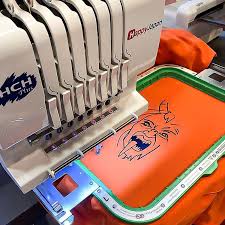Introduction
The convergence of fashion and technology has given rise to smart clothing—garments embedded with electronic components that monitor health metrics, enhance athletic performance, and provide therapeutic benefits. Central to this innovation is embroidery digitizing, a process that translates intricate designs into digital patterns for precise embroidery. This technique is now pivotal in integrating conductive threads into fabrics, enabling the creation of e-textiles that revolutionize wearable health technology.
Understanding Embroidery Digitizing
Embroidery digitizing involves converting artwork into a digital format that embroidery machines can interpret. This process ensures accurate stitching of designs onto fabrics. In the context of smart clothing, digitizing allows for the precise placement of conductive threads, forming circuits and sensors within garments without compromising comfort or aesthetics.
The Role of Conductive Threads in E-Textiles
Conductive threads, often made from silver-coated or carbon-based fibers, are essential in e-textiles. They facilitate the transmission of electrical signals, enabling functionalities such as:
- Health Monitoring: Tracking vital signs like heart rate, respiration, and body temperature.
- Activity Tracking: Monitoring movement and posture for fitness and rehabilitation purposes.
- Therapeutic Functions: Delivering electrical stimulation for muscle therapy.
Embroidery digitizing ensures these threads are accurately placed, maintaining the garment’s flexibility and durability.
Applications in Wearable Health Technology
- Smart Shirts for Cardiac Monitoring:
Garments embedded with embroidered sensors can continuously monitor heart activity, providing real-time data to healthcare providers. - Posture-Correcting Apparel:
Digitized embroidery enables the integration of sensors that detect and correct poor posture, beneficial for individuals with musculoskeletal issues. - Diabetic Monitoring Socks:
Socks with embroidered pressure sensors can detect changes in foot pressure, alerting diabetic patients to potential ulcers. - Athletic Performance Wear:
Sportswear with integrated sensors tracks muscle activity and fatigue levels, aiding in performance optimization and injury prevention.
Advantages of Embroidery Digitizing in Smart Clothing
- Precision: Ensures accurate placement of sensors and circuits.
- Customization: Allows for personalized designs catering to individual health needs.
- Aesthetics: Maintains the garment’s visual appeal while embedding technology.
- Durability: Enhances the longevity of smart garments through robust stitching techniques.
Challenges and Considerations
While embroidery digitizing offers numerous benefits, challenges include:
- Material Compatibility: Ensuring conductive threads are compatible with various fabrics.
- Washability: Maintaining sensor functionality after repeated laundering.
- Power Supply: Developing compact and flexible power sources for embedded electronics.
Addressing these challenges requires ongoing research and collaboration between textile engineers and healthcare professionals.
Future Outlook
The integration of embroidery digitizing in smart clothing is poised to advance further with developments such as:
- AI-Driven Design: Utilizing artificial intelligence to optimize sensor placement and functionality.
- Biodegradable Conductive Threads: Creating eco-friendly smart garments.
- Enhanced Data Analytics: Improving health monitoring through advanced data interpretation.
These innovations will expand the applications of smart clothing, making wearable health technology more accessible and effective.
Conclusion
Embroidery digitizing stands at the forefront of smart clothing innovation, transforming traditional garments into sophisticated health monitoring tools. By enabling the precise integration of conductive threads, this technology enhances the functionality, comfort, and appeal of wearable health devices. As research progresses, embroidery digitizing will continue to play a crucial role in the evolution of e-textiles, offering promising solutions for personalized healthcare and wellness.
❓ Frequently Asked Questions (FAQs)
1. What is embroidery digitizing in smart clothing?
Embroidery digitizing in smart clothing refers to the process of converting designs into digital embroidery files to precisely integrate conductive threads and sensors into garments. This technology enables the creation of wearable electronics for health monitoring and performance tracking.
2. How does embroidery digitizing support wearable health technology?
By ensuring the accurate placement of conductive threads and components, embroidery digitizing allows for the seamless integration of health-monitoring features like heart rate sensors, posture monitors, and temperature detectors into clothing.
3. Are garments with digitized embroidery washable?
Many smart garments are designed to be washable, but it depends on the materials and technology used. Advanced embroidery digitizing ensures durable placement of threads, but always follow manufacturer care instructions for best results.
4. Can embroidery digitizing be used for athletic performance wear?
Yes, digitized embroidery is ideal for athletic wear. It enables the integration of muscle sensors, fatigue detectors, and activity trackers, enhancing performance and reducing injury risks.
5. Is embroidery digitizing better than traditional sewing for smart clothing?
Yes. Embroidery digitizing offers more precision, customization, and durability compared to traditional sewing methods. It is especially beneficial when integrating complex circuitry into garments.
6. What materials are used in embroidery digitizing for smart clothing?
Common materials include conductive threads (silver-coated or carbon-based), flexible fabrics like spandex or polyester, and smart sensors. The digitizing process ensures these components are stitched correctly for maximum functionality.
7. Can I customize smart clothing with my own health needs?
Absolutely. Embroidery digitizing allows for high levels of customization, enabling designers to tailor sensor placements and functionalities based on individual health or fitness requirements.
8. Is embroidery digitizing expensive for smart wearables?
While it may have a higher upfront cost than traditional embroidery, the long-term benefits—like health tracking, durability, and precision—make it a worthwhile investment for many use cases.
9. What industries are using embroidery digitizing in smart clothing?
Industries include healthcare, sports and fitness, military, fashion tech, and elderly care. The technology is growing rapidly in all areas where health monitoring and performance optimization are needed.
10. What is the future of embroidery digitizing in e-textiles?
The future holds AI-driven design, eco-friendly conductive materials, enhanced data analytics, and increased accessibility, making embroidery digitizing a key player in the evolution of smart, functional apparel.


